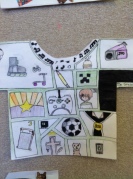You are currently browsing the tag archive for the ‘Gifted’ tag.
Tag Archive
Meta-Reflection: Human Development and Principles of Learning
March 10, 2013 in Curriculum and Instruction Standards, L3: Family/neighborhood centered, Standard 02. Learning Environment | Tags: EDU6655, Gifted, Learning Environment, Meta-Reflection, Prior Knowledge | Leave a comment
As I entered this class, I did not have a broad understanding of human development and the affect that it has on my classroom. While I had learned briefly about this in my undergraduate classes, I was excited to know more about the dynamics present in my room. Through reading The Jossey-Bass Reader along with a variety of articles and through discussing the principles presented in the texts, I left with a much stronger understanding of how the learning environment affects different students and what I can do to make sure that the learning environment encourages all students to learn and succeed. This class focused on Standard 2 of Learning Environment which states, “Creates and maintains school-wide and classroom environments that are safe, stable and empowering” (Curriculum and Instruction Graduate Standards, 2012).
One thing that stood out to me right away in this course was how different cultures interact socially and how this affects dynamics in the classroom. For example, collectivist cultures promote collective goals and individualism cultures favor individual rights (Hofstede, 2001). This greatly impacts the classroom environment when particular learning activities make some students feel very uncomfortable, while others feel right at home. A barrier for students in the classroom can be prior knowledge. “For example, if a learner has more prior knowledge of a topic area he/she might meet less difficulty when learning through the learning object, and vice versa” (Qi & Boyle, p. 3). Culture may also affect access to technology. If student are required to use technology to complete work, they may not be familiar with the programs or have access to the necessary devices.
In order to create a safe, respectful, positive learning environment, I start out the year by having students get to know each other through a couple of projects. Students created t-shirts that represent their interests, culture, beliefs, and family.
They then used these to share about themselves with the class. The “Citizenship Project” allows students to express who they are as individuals and what they contribute to the whole. Students begin by creating and individual block that examines who they are as an individual. They then meet with a group of four and explain who they are by describing what the images on the block represent. Next they glue their four small blocks on a larger piece of paper. This piece of paper describes the school. Each group discusses and then draws images that represent what they contribute to the school. The following day, they glue this piece of paper that represents the school onto an even larger piece of paper that represents the United States. The group meets to talk about the United States including the past, present, future, symbols, and figures of the country. Last students individually reflect on this process, considering who they are as individuals and how they fit into whole both as a member of our school & a member of our country. I think this helps to build a sense of community and helps students realize that even though their experiences may be different, they are valid and we can all learn something from their culture. I believe that it is important to be aware of these differences and work to be sensitive to all students’ backgrounds and needs while also help them to be successful in the society that they live in and will work in. By beginning with these conversations, respect and trust is built which helps as we move forward and continually make connections and comparisons to what we are learning about. This sometimes occurs in my classroom through students’ journals and classroom discussion.
It is important that all students are challenged and some students need additional support to make sure that this happens. For gifted and talented students, extensions may be needed to challenge them when they finish a task or to help them dig deeper rather than racing to the finish line. I believe that it is also important to encourage these student to look outside of themselves and help others, whether this be something that happens inside of your classroom or not (Brazelton & Greenspan, 2006). Through this, students are given the opportunity to develop cognitively, morally, and develop the ability to self-regulate (Cross, 2001)
